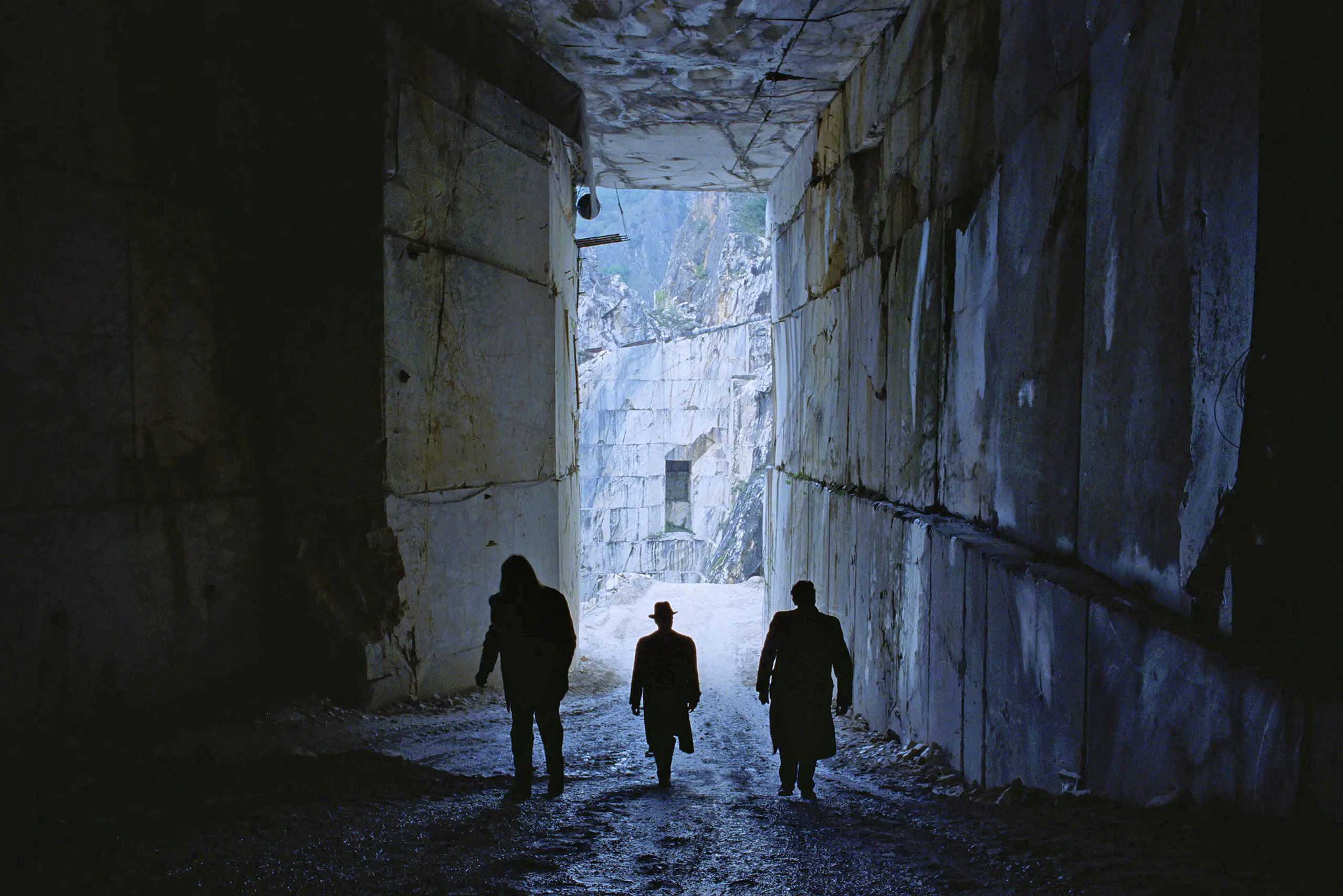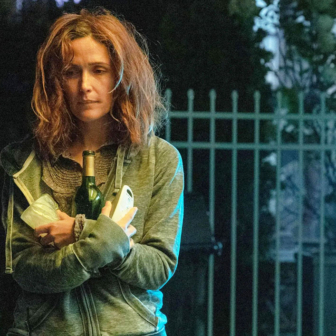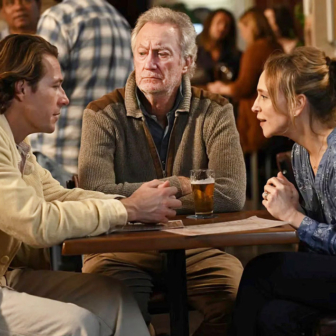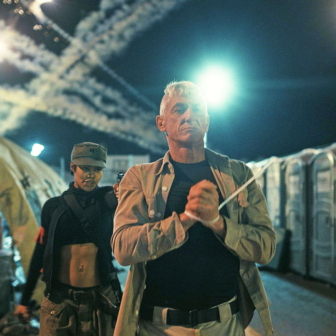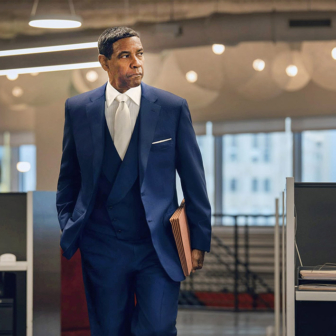Contains some plot details
Brady Corbet’s The Brutalist is an over-long epic about the making of a huge and, so far as we can tell, ugly building (though several characters insist it is “beautiful”). The building holds a secret, undivulged until the epilogue. That secret confirms what is intimated throughout the film, that Corbet sees it as an allegory of, or a moral fable about, or maybe just a suggestion pertaining to, the fate of post-Holocaust Jews in America.
The film follows the travails of its fictional hero, László Tóth (Adrien Brody), from his arrival at Ellis Island in 1947 (establishing shots of the Statue of Liberty, on her side or upside down, are a keynote metaphor) to his eventual settlement in Philadelphia (the city of brotherly love). It ends in the 1980s with a Tóth retrospective in Venice.
Once in the United States, Tóth picks up a career cut short in Europe before the war. He boards with his cousin Attila (Alessandro Nivola), designing knock-off Le Corbusier furniture for Attila’s modest homeware store, before being taken up by a wealthy businessman, Harrison Lee Van Buren Snr. (Guy Pearce). At the end of Part I, Van Buren presents Tóth with the commission that will occupy him for the next twenty years of his life. This is the Margaret Van Buren Center for Creation and Activity, named in honour of Van Buren’s recently deceased mother.
The film’s editing marshals a complicated storyline by a lingering and leaping technique: some episodes are dwelt upon in detail while others are skipped over, continuity is not always clear, and Corbet doesn’t trouble to complete several important trains of action. Does one character make a pass at another, thereby ending an important domestic arrangement? Has another character been seduced? What happens to the third character at the very end? How far these and other gaps are bug and how far feature is hard to determine.
The film was mainly shot in Hungary on a small budget ($10 million) in just thirty-three days. To surmount the problem of making present-day Budapest look like fifties’ Philadelphia, Corbet intercuts contemporary civic promotional footage that presents the city as the mid-century powerhouse of American industry. The acting is uniformly strong, capped by a bravura, if at times overwrought, performance by Brody. A few complaints: the script lets itself down on occasion, as when one character mentions the “significant others” of another, or someone says that someone else’s mother “has passed”; a subplot involving two Black characters, Gordon and his son William, doesn’t go anywhere; the score by Daniel Blumberg is over-insistent.
Anyone expecting insights into an architectural style called Brutalism will come away disappointed. Tóth’s building is more Bauhaus than Brutalist. How typical Tóth is of other ex-patriate European Jewish architects associated with either the Bauhaus or Brutalism is not considered. He is presented as a lonely architectural pioneer with no professional contemporaries, colleagues or contacts. The film does not allude to the many ex-Bauhaus architects already established in America, especially at Harvard. The omission of Louis Kahn, whose Yale University Center for Art, a near-Brutalist building, was completed in 1953, is striking, given that Kahn ran an architectural practice in Philadelphia in a timeframe overlapping the action of the film. This untethering of Tóth’s imaginary story from the real story of real architects thins out the air of reality.
But the film’s title is not “Brutalism” but “The Brutalist” and it may be conceded that, historical considerations aside, it legitimately concentrates less on architectural history and more on the degree of brutality — brute personal history, brute determination, brute struggle — required to realise a gigantic architectural commission. Tóth’s own brutality, alleviated by indications of his essential kindness and cultivation, is what enables him to survive and succeed. His story obeys a familiar story pattern, that of the male hero’s journey, in effect A Quest. Such a hero needs a field of action, involvement with the world’s materials — wood, coal, steel, concrete — and above all, participation in conflict, contest and struggle.
Tóth’s wife Erzsébet (Felicity Jones) turns out to be a journalist (she studied English at Oxford), but the women in the film stand apart from the main action. The character of Van Buren’s daughter Maggie Lee (Stacy Martin) is underdeveloped, but what is there — her sympathy for the Tóths, for example — suggests that much more could have been made of her character.
We first see Tóth in a state of abjection, following on from some form of internment, we guess, most probably a concentration camp, although this is not yet made clear. His initial design efforts in Philadelphia — remodelling Van Buren’s library in the Bauhaus style — are met with derision and rejection. The new library is, in fact, one of the film’s visual triumphs: wholly convincing, elegant, stylish and functional. Sacked, Tóth finds work as a rigger and labourer. Then Van Buren, chancing on an article in Look magazine, discovers the pedigree of the man he has spurned and offers Tóth a second chance.
In another memorable set-piece, and the climax of Part I, Van Buren troops his dinner guests out into the cold evening air and up a prominent hill near his house overlooking the exurb of Doylestown (a real place). He announces that the Margaret Van Buren Center will be built on this spot, and that Tóth will be its architect and builder. In Part II, with the help of Van Buren, Tóth is reunited with his wife, unexpectedly confined to a wheelchair, and his beloved niece, Zsófia (Raffey Cassidy).
Progress on the centre is punctuated by series of setbacks, cost-overruns, and quarrels over materials and construction methods. The principal conflict is over what kind of building the centre should be; whether it will be three buildings in one, a community centre, a gymnasium and a library, a secular community asset, as Tóth wants; or four buildings, as the Doylestown council wants, and Van Buren supports, with the important addition of a chapel. (In fact, the chapel seems to replace the library.) This modification, resisted but eventually accepted by Tóth, is the crux, both literal and figurative, of the story.
The monumental sculptural edifice Tóth engineers — shown by what must be Potemkin-Village-like structures made of frame and canvas or building board intercut with shots of real buildings that might plausibly be part of the centre — is charged with symbolic value. It is crowned by twin towers, each one with an inset notched into the top, creating twin balconies that mirror and overlook each other.
The towers might be belltowers, they might be watchtowers. They certainly embody the Christianising of what had originally been a secular building. As seen in silhouette the negative space between them forms a gigantic cross. Tóth so orients the building that at its zenith the sun over the towers will project a cross onto an altar far below (although only on a few days a year, the sceptic within might murmur).
By the end of Part I we are beginning to understand that Tóth is not the titular brutalist after all. That role belongs to Van Buren Snr., a stock Yankee/WASP capitalist. Guy Pearce is a little too pompous in this role, but he is dealing with a script that doesn’t offer him a lot to go on. The most interesting, although undeveloped, aspect of Van Buren’s character is that he never mentions his father but is clearly fixated on his mother. She is ill at the start of the film, and her vulnerability as a sick (although off-screen) woman helps fuel Van Buren’s outrage at the remodelling of his library. After her death she haunts the film in the form of the memorial centre. Although she never appears she is the most important character in the film, the motor of the plot.
So far as Tóth is concerned, Van Buren is a helper and an antagonist, but also something much worse. He is not entirely without kindness or sympathy, he is not a complete philistine, nor does he appear to be an anti-Semite. The discreet sign of an endemic but well-concealed prejudice against Jews is given by Van Buren’s son, Harry Lee, who, having announced his desire to “slip my prick” into Zsófia, adds “you know, we tolerate you people.” This sort of attitude is the subtext of the foisting of a Christian purpose on a building that Tóth had originally envisaged as a secular community asset.
Underlying hostility toward the Jews that America has welcomed is brought to a critical point in a long and spectacular episode set in the quarries of Carrara. (Historically the Roosevelt administration had been reluctant to offer admission to European Jews, a policy supported by conservatives in the Jewish community on the grounds that an influx of co-religionists would exacerbate native anti-Semitism.) Tóth and Van Buren have travelled there to select the marble for the altar. The establishing shots of the Carrara quarries are the visual high point of the film. In one memorable scene Van Buren lays his cheek against the huge chunk of marble and weeps. Marble, because of its association with the iconography of the church, is meant to contrast with the democratic concrete so beloved by Tóth, on which no one lays their cheek and weeps.
The quarry scenes conclude, a little implausibly, with a dance party deep in the mines under the mountain, where László dances with a flirtatious younger woman under the watchful eye of Van Buren. This is a prelude to an unexpected scene in which Van Buren stalks a drunken Tóth through the labyrinthine corridors deep under the mountain, and finding him collapsed on the ground, insults and then violates him.
Or does he? We see the attack only as two silhouetted figures struggling in the middle ground and it is hard to know what, exactly, has taken place. And yet later, in the film’s melodramatic climax, Tóth’s wife, now able to walk with the help of a frame, forces her way into Van Buren’s house late at night and denounces him before his family and friends as a rapist. The rape clinches the argument of the film about the fate of post-Holocaust Jews in America, a case strongly reinforced by two subplots showing the contrasting responses to America of two other émigré Jews.
On the one hand, there is Toth’s cousin, Attila (Alessandro Nivola), the owner of the furniture shop. Attila, an enterprising but conventional shopkeeper, has been in the States since before the war and has fully assimilated himself. He has married Audrey (Emma Laird), a Massachusetts Catholic, and has become a convert himself. Once Attila Molnár he is now Attila Miller. The episodes early in the film dramatizing the László, Attila and Audrey triangle are one of the most absorbing parts of the film, with an especially strong performance from Nivola. The warmth of the relationship between the cousins, the pride Attila feels in his business and his wife, his need to show Audrey off and yet, dangerously, press László to dance with her, the sexual tension between László and Audrey, the turning of Audrey against László, and the inevitable break between the cousins, is all absorbingly and convincingly shown.
On the other hand, there is László’s niece, Zsófia. In the opening scenes she is in what appears to be a DP camp in Hungary where she has been looked after by Erszébet. The film opens with an interrogation of Zsófia by an unseen official in which, despite a barrage of questions, she says nothing. She then says nothing for the following two hours. What has caused her aphonia? Erzsébet insists that she has kept Zsófia “safe,” especially from the attentions of two Russian soldiers, although it is possible to think that Erzsébet is shielding László here from a horrible truth.
Zsófia’s aphonia is perhaps the hint of an earlier violation in the manner of another literary wartime mute, Kattrin, in Brecht’s Mother Courage. But Zsófia’s later silence is also political, a refusal, unlike Attila, to join America. Zsófia speaks only when she has found a fiancé, and the pair announce they will “make Aliyah.” As to America, “this country is rotten,” Erzsébet (a convert to Judaism) says.
These sub-plots — one about acquiescence, one about refusal — throw light on the more insidious attack America mounts on Tóth. America welcomes Jewish émigrés, but it subtly deracinates them. Tóth’s secret act of resistance is encoded in the building, revealed only in the epitaph, spoken by the adult Zsófia, with her child in attendance, in the presence of the aged Tóth, by now a maimed, Rochester-like figure — wheelchair bound, possibly blinded, his face disfigured by a stroke, a man whose victory has been achieved at the cost of an assault upon him of which the rape is but the outward sign.
In this secret, the Van Buren Center, a Christian building in Christian America, is at the same time a memorial of the century’s darkest event. It makes the film more than an epic about one man’s achievement, but a story about the fate of Jews in America. How far we are encouraged to revise the optimist view of Israel that key characters express in the light of the country’s later history remains an open question, and one that will no doubt be answered in different ways by different viewers. •
